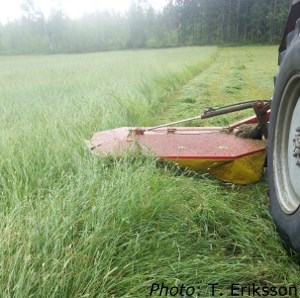Project responsible: Torsten Eriksson, Department of Animal Nutrition and Management (HUV); Feed Science Division.
Project group: Horacio Gonda; Kamyar Mogodiniyai Kasmaei and Bengt-Ove Rustas, all HUV.
Reference person: Erik Dahlén, Stockholm Exergi
In addition to being a carbon sink, there are indications that biochar possess several properties that may contribute to payoff for its inclusion in the chain feed-milk production-manure management-crop production. This could be either directly by improving production/saving costs, or indirectly by environmental benefits that gives acceptance for a higher consumer price or motivates some economical premium from society.
This project investigates and quantifies such effects on several key points in the feed chain of the organic dairy farm.
- Biochar as a silage additive for improved nutritional value and safer ensiling. Ley crops are commonly wilted to facilitate ensiling and restrict fermentation so that more protein and carbohydrates remain intact after ensiling. The extent of wilting is limited by impaired packing properties, increased leaf loss and a larger weather dependence. Our hypothesis is that biochar addition by reducing water activity may give an effect similar to extensive wilting at lower dry matter concentration with retained packing properties and without leaf loss.
- Biochar for reducing ruminal formation of methane and ammonia. Silage with biochar addition will be investigated in vitro under the hypothesis that methane formation and ruminal liquid ammonia concentration are reduced.
- Biochar in the feed for more firm manure and cleaner animals. Silage with biochar addition will be fed to heifers. Manure consistency and animal cleanliness will be investigated under the hypothesis that biochar will give firmer manure and cleaner animals and that the effects are similar regardless if biochar is added at ensiling or prior to feeding.
- Biochar to reduce formation of methane and ammonia during slurry storage.
